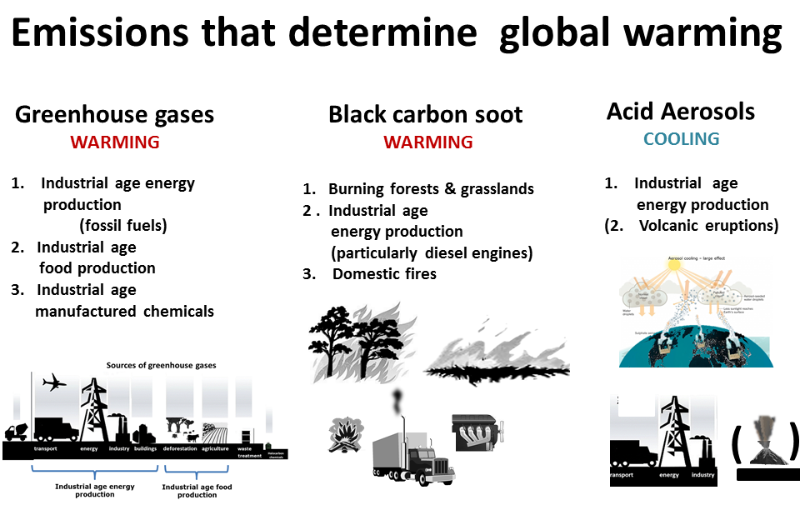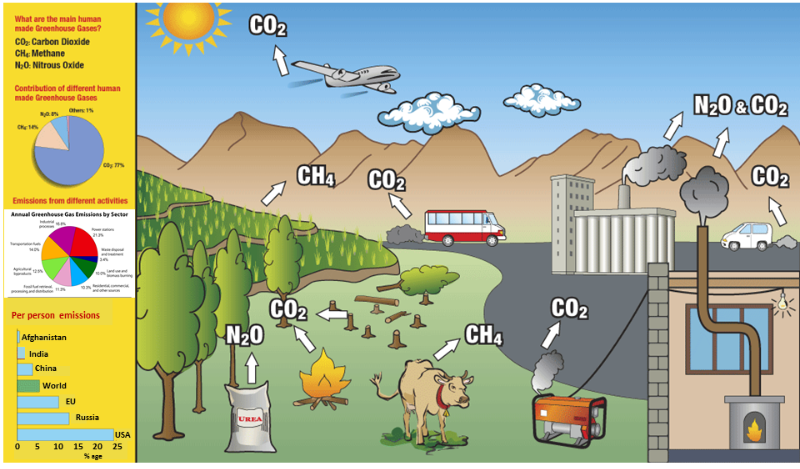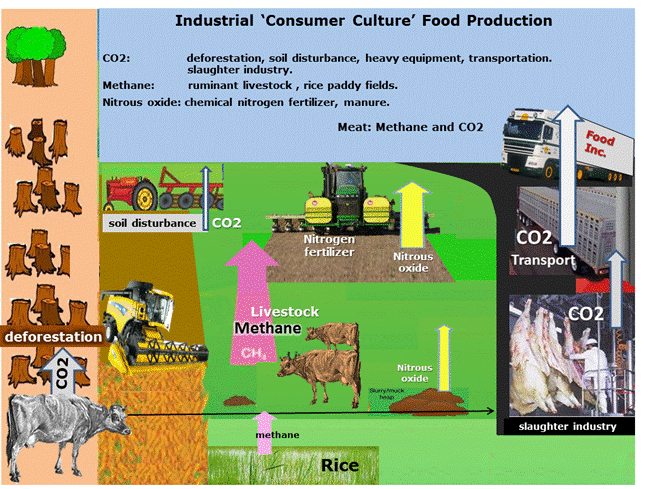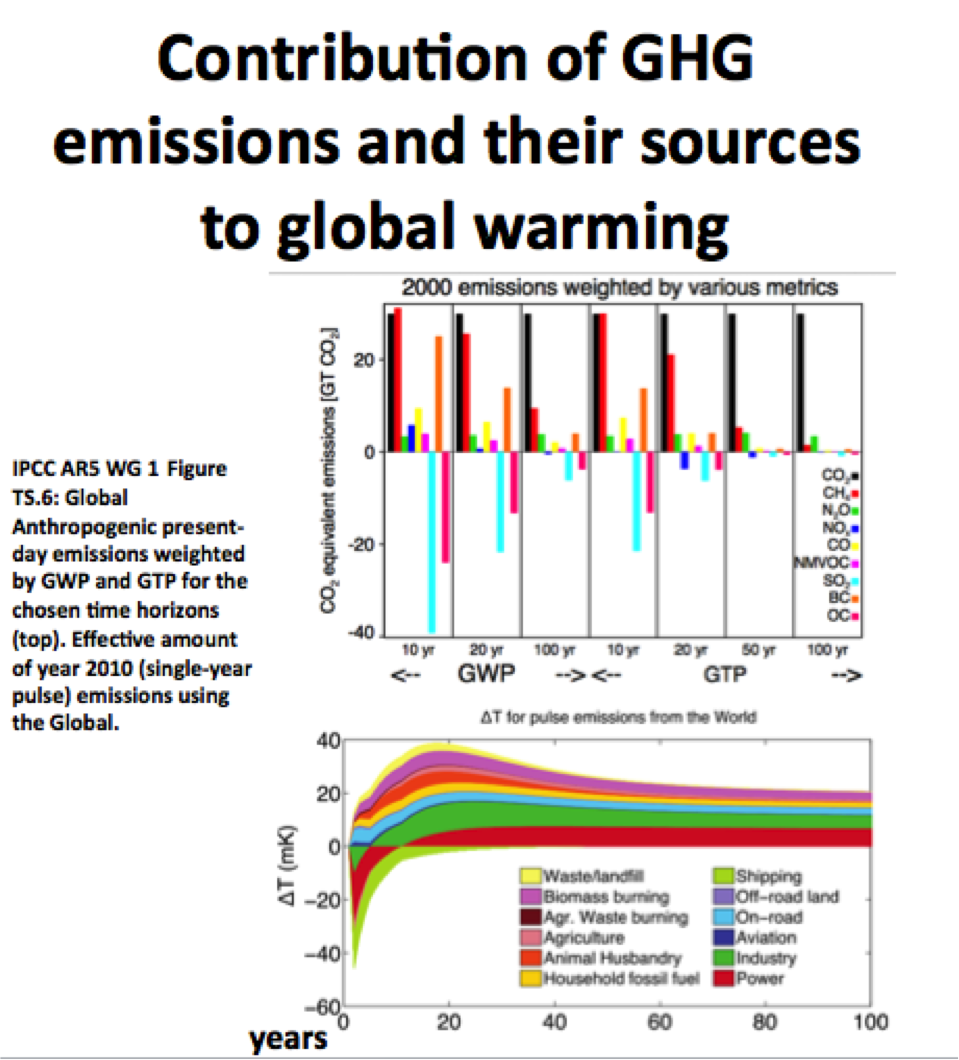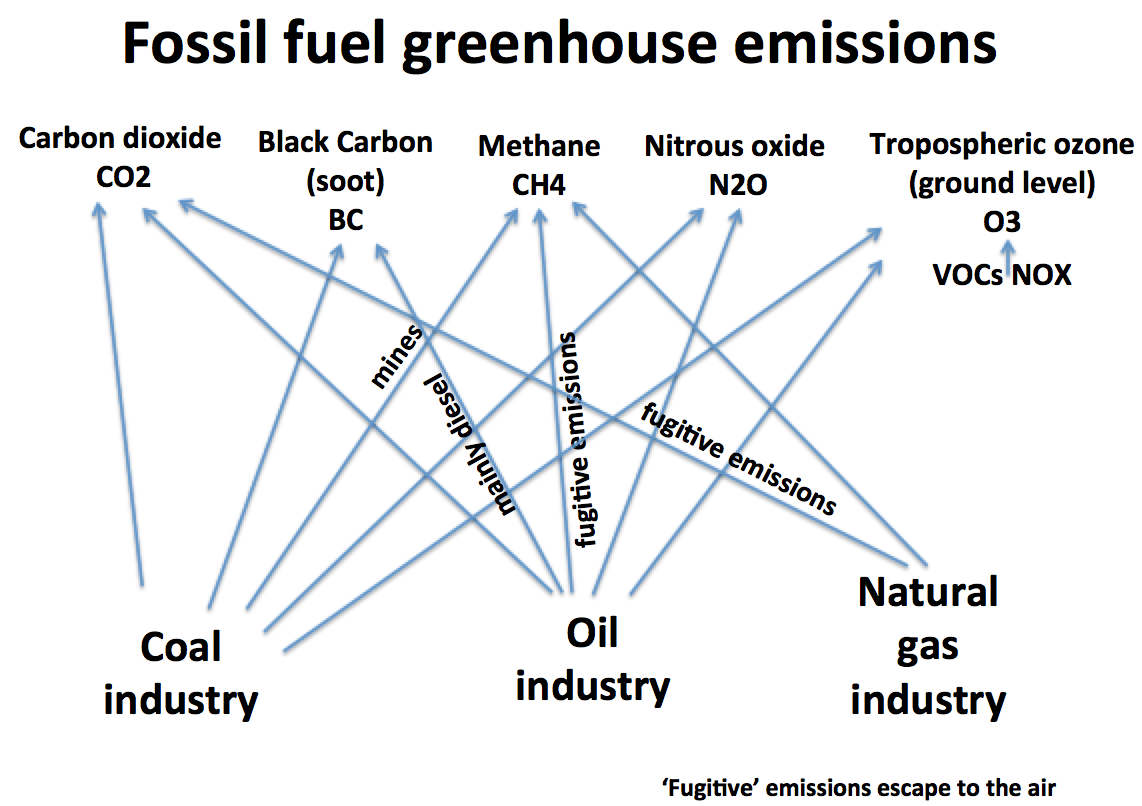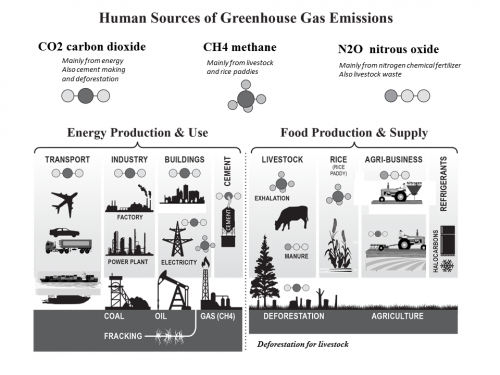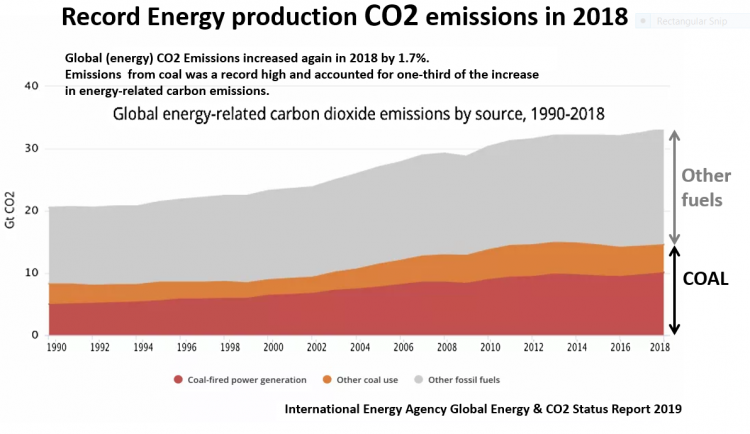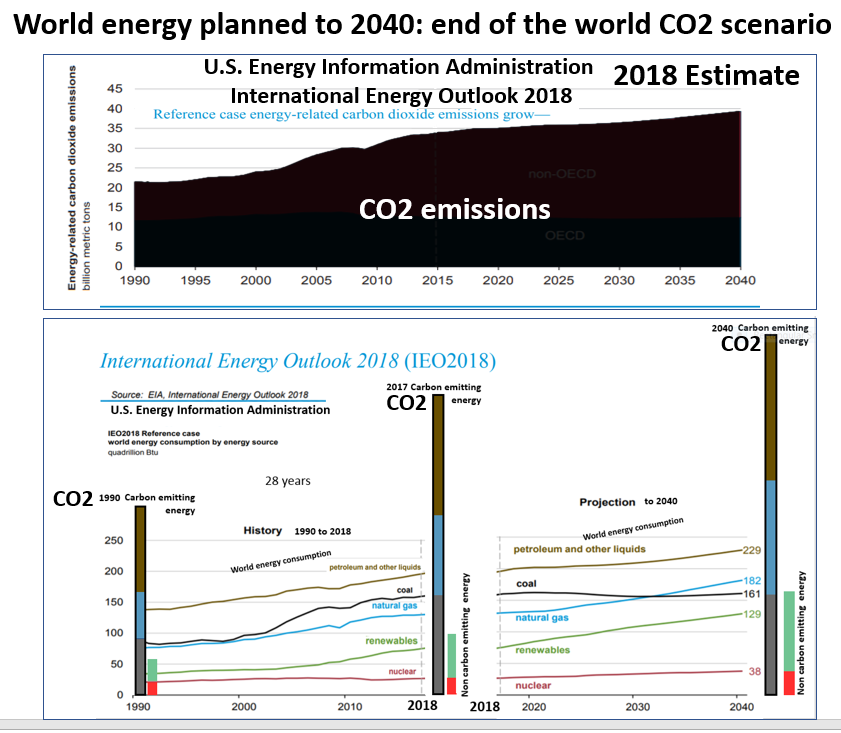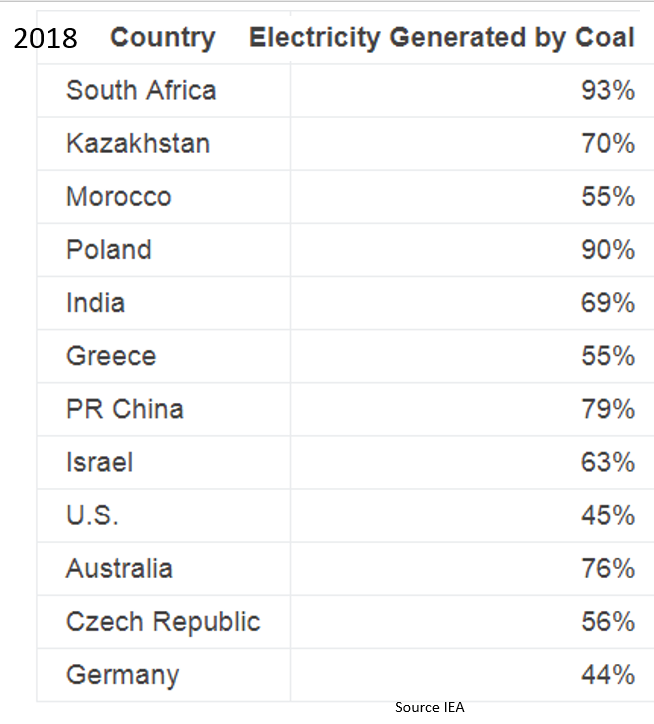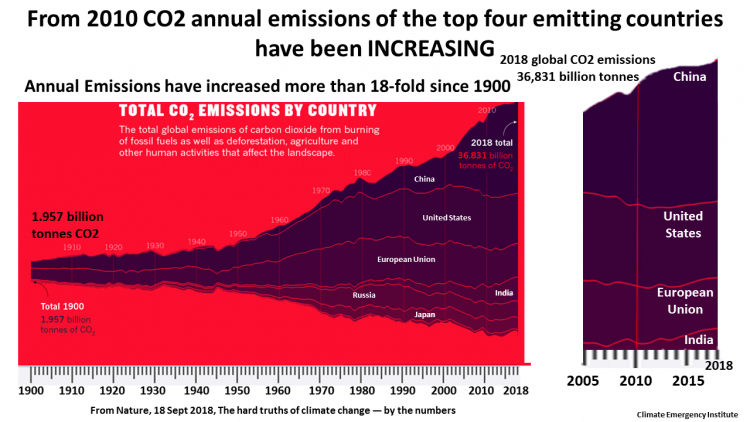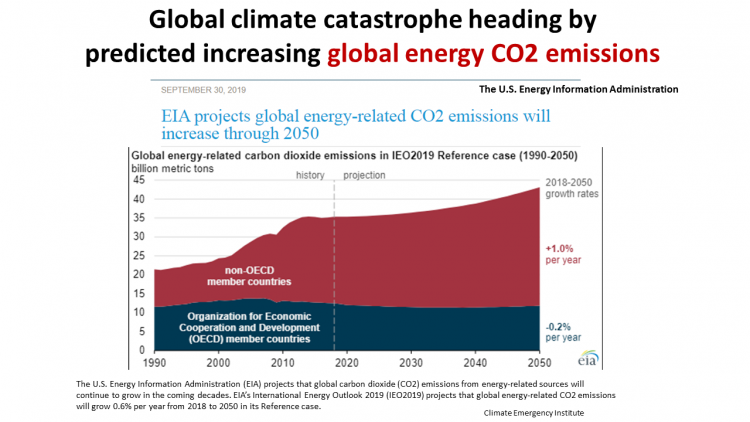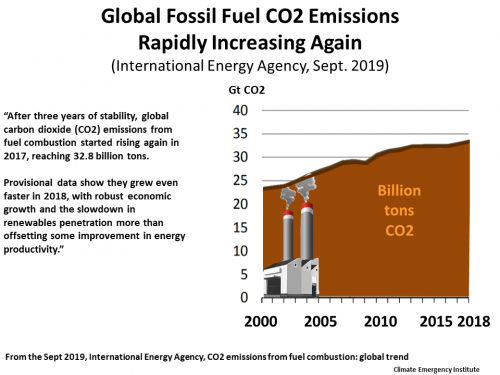Greenhouse emissions
Though the main greenhouse gases (carbon dioxide oxide, methane, nitrous, ground level ozone) cause most of the warming we have talk about 'greenhouse emissions' because recent research has found that black carbon (soot) is probably second to CO2 as an emission causing global warming. Fossil fuels are well known as the main source of CO2 but also are a source of almost greenhouse emissions.
Black carbon soot
Black carbon causing warming in two ways. Being black soot is a good heat absorber in the atmosphere and also on snow where it reduces the albedo cooling effect.
Acid aerosol cooling emissions
Also we must remember the the warming from greenhouse
emissions is off set by acid aerosol cooling emissions,
from volcanic eruptions transiently and fossil fuel air
pollution constantly.
Emissions
Fossil fuels
Industrial energy production is the main source of GHG emissions
become over 80% of the energy comes from burning and there are
no plans to change this.
The source of energy that made for the easy labor saving affluent lives of many, is now ruining life in the future for us all through the constant
emission of very last lasting GHGs (mainly CO2) into the atmosphere.
Fossil fuel toxic emissions disable and kill a huge number of people through toxic air pollution. Most of the chronic disorders of the industrialized world have a fossil factor causing them.
FOSSIL FUEL GREENHOUSE EMISSIONS
Fossil fuels are the major source of CO2 emissions and coal has always been the worst for toxic air pollution and GHG emissions (including CO2 ocean acidification). Most countries still rely on coal and still subsidize coal.
But are also several other greenhouse emissions.
Methane and nitrous oxide (a little) is emitted by fossil fuels. Methane as fugitive emissions from natural gas (mainly methane)and from coal mining, and (research June 2014) also abandoned oil wells.
Tropospheric (ground level) ozone is a GHGs, formed by a chemical reaction between air pollutants emitted by fossil fuels catalyzed by sun warmth.
Fossil fuels are a source of BC Black Carbon (soot) mainly from diesel engines.
Ethane Propane and Butane
These GHGs are all fugative emissions from the natural gas industry, especially now fracking.
Ethane is emitted from the use of fossil fuels generally and as such has been used a fossil fuel carbon emissions marker. Ethane is also involved in the chemical reaction producing ground ozone in the air (a GHG).
Fossil fuels are the main source of air pollution cooling aerosols, but that is also a very bad thing. The fossil fuel air pollution cooling masks a lot of the CO2 warming. This deferred heat will be unmasked by counties having to clean up their air pollution and because the world has to stop burning fossil fuels - the zero carbon imperative for stabilization.
Fossil fuel pollution as well as heating the planet today, is storing up much more heat that will hit us hard in the future and last practically for ever.
Zero carbon emissions
The science is definite that to stabilize global temperature and ocean acidification we must stop all industrial carbon emissions.
Instead of heading towards zero CO2 emissions, they are increasing and faster than ever.
Ever since 2008 the International Energy Agency in its annual World Energy Outlook has been warning that the world is on energy-emissions scenario that leads to a warming of at least 6C by 2100.
That is actually the most accurate global temperature prediction from anywhere.
In July 2013 the US Energy Information Administration projected world energy consumption will increase 56% by 2040 and that the vast majority of it will still be fossil fuels.
That is clearly a planetary emergency because atmospheric greenhouse concentrations are at an extreme unprecedented (never before) high level already.
CO2 equivalent emissions
It is most important that emissions are by CO2 equivalent rather by CO2 only as is often the case.
CO2 equivalent includes methane and nitrous oxide calculated as the equivalent amount of CO2
Emissions are a new record every year.
2012 was a new record on world carbon emissions.
Other non CO2 greenhouse gas emissions continue to increase.
Industrial food production if fully estimated comes close to industrial energy production in emitting GHGs.
Methane: main source of emissions is livestock (ruminants exhale methane from digesting grasses)
The industrial age diet is meat heavy- bad for people and the planet.
Nitrous oxide: main source is large scale agriculture that depends on large amounts of chemical nitrogen fertilizer, which is made from natural gas.
Another food production source is livestock waste.
Fossil fuel energy is used by industrial food production due to a lot of long and short distance food transportation and refrigeration.
Deforestation is a large source of CO2 emissions, because clearing o forest allows the carbon on and in the forest floor to be emitted and there is no forest left to re-absorb the carbon.
CLIMATE EMERGENCY INSTITUTE
The health and human rights approach to climate change
UN Climate Secretariat August 2019 Climate Action & Support Trends update of NDCs (national emissions targets) projects
A simple way to look at GHG emissions is from 2 big main sources- industrial energy production/use and industrial food production/use
Research
By date
3 March 2021 Fossil CO2 emissions in the post-COVID-19 era (governments pushing fossil fuels back up
9 Feb 2021 Fossil fuel air pollution responsible for more than 8 million people worldwide in 2018 1 in 5 deaths
6 Nov 2020 Global food system emissions could preclude achieving the 1.5° and 2°C climate change targets(30% of emissions)
21 Sept 2020 OXFAM Confronting Carbon Inequality Carbon emissions of richest 1 percent more than double the emissions of the poorest half of humanity.
3 Aug 2020 RCP8.5 tracks cumulative CO2 emissions (worst-case)
5 Mar 2020 Emissions: world has four times
the work or one-third of the time
19 Feb 2020 Preindustrial CH4 indicates greater anthropogenic fossil CH4 emissions
Feb 2020 US Fracking's Bridge to Climate Chaos
Dec 2019 IEA Coal Global coal use has never been higher, at 40% of electricity. Coal will increase 4.6% per year to 2024, stable through at least 2040.
Dec 2019 Global Carbon Project Fossil CO2 Increased
18 Nov 2019 Acceleration of global N2O emissions seen from two decades of atmospheric inversion
Sept 2019 IEA CO2 emissions from fossil fuel combustion
2 August 2019 Efficacy of black carbon aerosols: the role of shortwave cloud feedback (larger)
2 July 2019 Modeling global radiative effect of brown carbon: A larger heating source ...
20 June 2019 U.S. military consumes more hydrocarbons than most countries -- massive hidden impact on climate
27 June 2019 Planes are even worse for the climate than we thought: contrails
6 June 2019 Fertilizer plants emit 100 times more methane than reported
Feb 2019 Plastic source of emissions
30 Jan 2019 CO2 emissions rate 10X higher than PETM
27 Aug 2018 Black carbon radiative effects highly sensitive
to emitted particle size (underestimated)
10 Sept 2018 High nitrous oxide fluxes from rice indicate the need to manage water for both long- and short-term climate impacts. i.e. N2O in addition to methane emissions
1 June 2018 Reducing food’s environmental impacts through producers and consumers Food Emissions
6 June 2011 Carbon emissions are 10X faster than the PETM (56M years ago)
Sept 2018 IEA World Energy Stats
National emissions targets are for a substantial global increase by 2030 which is a global suicide scenario (published 2019).
CO2 Emissions 2018
25 Oct 2019 Share of world's total energy provided by fossil fuels unchanged at 81%: UN rapporteur
2019
Dec 2019, PBL, Trends in Global CO2 and Total Greenhouse Gas emissions.
Global GHG emissions increased 2% in 2018 55.6Gt CO2 eq.
National emissions targets
Coal
THE WORLD ECONOMY IS TRACKING THE WORST-CASE SCENARIO
3 Aug 2020 RCP8.5 tracks cumulative CO2 emissions (WORST-CASE)
Jan 2021 Fossil fuels 8 million deaths/year
